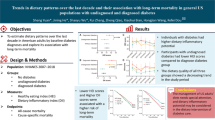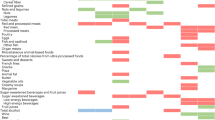Abstract
Background
Epidemiological studies on the relationship between dietary glycemic index (GI), glycemic load (GL) and all-cause and cause-specific mortality yielded conflict results. We aimed to assess these associations in Chinese.
Methods
We conducted this study based on two prospective cohort studies in Shanghai. Dietary information was collected using validated cohort-specific food frequency questionnaires. We used Cox regression model to estimate the hazard ratios (HR) for mortality associated with GI and GL.
Results
After median follow-up periods of 12.8 years for 59,770 men and 18.2 years for 74,735 women, 8,711 deaths in men and 10,501 deaths in women were documented. After we controlled the potential confounders, dietary GI, GL, and carbohydrate intake were associated with a higher risk of cardiovascular disease (CVD) mortality (P values for trend = 0.025, 0.001, and 0.001). Dietary GI was associated with lower risk of total and cause-specific mortality in men in the second quartile (Q) (all-cause mortality: HR Q2 vs. Q1 = 0.89, 95%CI: 0.84, 0.95). Dietary GL was associated with lower risk of cancer mortality but higher risk of CVD mortality in men. In women, dietary GI was associated with mortality due to all-cause (HRMax Q4 vs. Q1 = 1.10, 95%CI: 1.04, 1.06), cancer (HRMax Q4 vs. Q1 = 1.12, 95%CI: 1.02, 1.23), and CVD (HRMax Q4 vs. Q1 = 1.10, 95%CI: 1.00, 1.22).
Conclusions
The present study indicates that diet with higher GI and GL was associated with an increased risk of CVD mortality in Chinese adults. The association may vary for men and women, which need further investigating in other Asian populations.
This is a preview of subscription content, access via your institution
Access options
Subscribe to this journal
Receive 12 print issues and online access
$259.00 per year
only $21.58 per issue
Buy this article
- Purchase on Springer Link
- Instant access to full article PDF
Prices may be subject to local taxes which are calculated during checkout
Similar content being viewed by others
References
Seidelmann SB, Claggett B, Cheng S, Henglin M, Shah A, Steffen LM, et al. Dietary carbohydrate intake and mortality: a prospective cohort study and meta-analysis. Lancet Public Health. 2018;3:e419–e428.
Mazidi M, Katsiki N, Mikhailidis DP, Sattar N, Banach M. Lower carbohydrate diets and all-cause and cause-specific mortality: a population-based cohort study and pooling of prospective studies. Eur Heart J. 2019;40:2870–9.
Jenkins DJ, Wolever TM, Taylor RH, Barker H, Fielden H, Baldwin JM, et al. Glycemic index of foods: a physiological basis for carbohydrate exchange. Am J Clin Nutr. 1981;34:362–6.
Salmeron J, Manson JE, Stampfer MJ, Colditz GA, Wing AL, Willett WC. Dietary fiber, glycemic load, and risk of non-insulin-dependent diabetes mellitus in women. JAMA. 1997;277:472–7.
Ludwig DS. The glycemic index: physiological mechanisms relating to obesity, diabetes, and cardiovascular disease. JAMA. 2002;287:2414–23.
Sieri S, Krogh V, Agnoli C, Ricceri F, Palli D, Masala G, et al. Dietary glycemic index and glycemic load and risk of colorectal cancer: results from the EPIC-Italy study. Int J Cancer. 2015;136:2923–31.
Amadou A, Degoul J, Hainaut P, Chajes V, Biessy C, Torres Mejia G, et al. Dietary carbohydrate, glycemic index, glycemic load, and breast cancer risk among Mexican women. Epidemiology. 2015;26:917–24.
Xu WH, Xiang YB, Zhang X, Ruan Z, Cai H, Zheng W. et al. Association of dietary glycemic index and glycemic load with endometrial cancer risk among Chinese women. Nutr Cancer. 2015;67:89–97.
Turati F, Galeone C, Gandini S, Augustin LS, Jenkins DJ, Pelucchi C, et al. High glycemic index and glycemic load are associated with moderately increased cancer risk. Mol Nutr Food Res. 2015;59:1384–94.
Turati F, Galeone C, Augustin LSA, La Vecchia C. Glycemic index, glycemic load and cancer risk: an updated meta-analysis. Nutrients. 2019;11:2342.
Bhupathiraju SN, Tobias DK, Malik VS, Pan A, Hruby A, Manson JE, et al. Glycemic index, glycemic load, and risk of type 2 diabetes: results from 3 large US cohorts and an updated meta-analysis. Am J Clin Nutr. 2014;100:218–32.
Livesey G, Taylor R, Livesey HF, Buyken AE, Jenkins DJA, Augustin LSA, et al. Dietary glycemic index and load and the risk of type 2 diabetes: a systematic review and updated meta-analyses of prospective cohort studies. Nutrients. 2019;11:1280.
Mirrahimi A, Chiavaroli L, Srichaikul K, Augustin LS, Sievenpiper JL, Kendall CW, et al. The role of glycemic index and glycemic load in cardiovascular disease and its risk factors: a review of the recent literature. Curr Atheroscler Rep. 2014;16:381.
Yu D, Shu XO, Li H, Xiang YB, Yang G, Gao YT, et al. Dietary carbohydrates, refined grains, glycemic load, and risk of coronary heart disease in Chinese adults. Am J Epidemiol. 2013;178:1542–9.
Jayedi A, Soltani S, Jenkins D, Sievenpiper J, Shab-Bidar S. Dietary glycemic index, glycemic load, and chronic disease: an umbrella review of meta-analyses of prospective cohort studies. Crit Rev Food Sci Nutr. 2020:1–10.
Castro-Quezada I, Sanchez-Villegas A, Estruch R, Salas-Salvado J, Corella D, Schroder H, et al. A high dietary glycemic index increases total mortality in a Mediterranean population at high cardiovascular risk. PLoS One. 2014;9:e107968.
Baer HJ, Glynn RJ, Hu FB, Hankinson SE, Willett WC, Colditz GA, et al. Risk factors for mortality in the Nurses’ Health Study: a competing risks analysis. Am J Epidemiol. 2010;173:319–29.
Levitan EB, Mittleman MA, Hakansson N, Wolk A. Dietary glycemic index, dietary glycemic load, and cardiovascular disease in middle-aged and older Swedish men. Am J Clin Nutr. 2007;85:1521–6.
Nagata C, Wada K, Tsuji M, Kawachi T, Nakamura K. Dietary glycaemic index and glycaemic load in relation to all-cause and cause-specific mortality in a Japanese community: the Takayama study. Br J Nutr. 2014;112:2010–7.
Burger KN, Beulens JW, van der Schouw YT, Sluijs I, Spijkerman AM, Sluik D, et al. Dietary fiber, carbohydrate quality and quantity, and mortality risk of individuals with diabetes mellitus. PLoS One. 2012;7:e43127.
Belle FN, Kampman E, McTiernan A, Bernstein L, Baumgartner K, Baumgartner R, et al. Dietary fiber, carbohydrates, glycemic index, and glycemic load in relation to breast cancer prognosis in the HEAL cohort. Cancer Epidemiol Biomark Prev. 2011;20:890–9.
Levitan EB, Mittleman MA, Wolk A. Dietary glycemic index, dietary glycemic load and mortality among men with established cardiovascular disease. Eur J Clin Nutr. 2009;63:552–7.
Shu XO, Li H, Yang G, Gao J, Cai H, Takata Y, et al. Cohort profile: the Shanghai Men’s Health Study. Int J Epidemiol. 2015;44:810–8.
Zheng W, Chow WH, Yang G, Jin F, Rothman N, Blair A, et al. The Shanghai Women’s Health Study: rationale, study design, and baseline characteristics. Am J Epidemiol. 2005;162:1123–31.
Villegas R, Yang G, Liu D, Xiang YB, Cai H, Zheng W, et al. Validity and reproducibility of the food-frequency questionnaire used in the Shanghai men’s health study. Br J Nutr. 2007;97:993–1000.
Shu XO, Yang G, Jin F, Liu D, Kushi L, Wen W, et al. Validity and reproducibility of the food frequency questionnaire used in the Shanghai Women’s Health Study. Eur J Clin Nutr. 2004;58:17–23.
Yang YX, Wang GY, Pan XC. China Food Composition Tables 2002, Beijing University Medical Press: Beijing, China, 2002.
Foster-Powell K, Holt SH, Brand-Miller JC. International table of glycemic index and glycemic load values: 2002. Am J Clin Nutr. 2002;76:5–56.
Miller JB, Pang E, Broomhead L. The glycaemic index of foods containing sugars: comparison of foods with naturally-occurring v. added sugars. Br J Nutr. 1995;73:613–23.
Wolever TM, Jenkins DJ, Jenkins AL, Josse RG. The glycemic index: methodology and clinical implications. Am J Clin Nutr. 1991;54:846–54.
World Health Organization. International Classification of Diseases: Manual of the International Statistical Classification of Diseases, Injuries, and Causes of Death. Ninth Revision., World Health Organization: Geneva, Switzerland, 1977.
Willett WC, Howe GR, Kushi LH. Adjustment for total energy intake in epidemiologic studies. Am J Clin Nutr. 1997;65:1220S–8S.
Schoenfeld D. Partial residuals for the proportional hazards regression model. Biometrika. 1982;69:239–41.
Desquilbet L, Mariotti F. Dose-response analyses using restricted cubic spline functions in public health research. Stat Med. 2010;29:1037–57.
Mekary RA, Rimm EB, Giovannucci E, Stampfer MJ, Willett WC, Ludwig DS, et al. Joint association of glycemic load and alcohol intake with type 2 diabetes incidence in women. Am J Clin Nutr. 2011;94:1525–32.
Oba S, Nagata C, Nakamura K, Fujii K, Kawachi T, Takatsuka N, et al. Dietary glycemic index, glycemic load, and intake of carbohydrate and rice in relation to risk of mortality from stroke and its subtypes in Japanese men and women. Metabolism. 2010;59:1574–82.
Jenkins DJA, Dehghan M, Mente A, Bangdiwala SI, Rangarajan S, Srichaikul K, et al. Glycemic index, glycemic load, and cardiovascular disease and mortality. N Engl J Med. 2021;384:1312–22.
Coleman HG, Kitahara CM, Murray LJ, Dodd KW, Black A, Stolzenberg-Solomon RZ, et al. Dietary carbohydrate intake, glycemic index, and glycemic load and endometrial cancer risk: a prospective cohort study. Am J Epidemiol. 2014;179:75–84.
Li H, Liu H, Chen J, Li L, Wang H, Li J, et al. Relationship between glycemic load and blood lipid level in hospitalized adult Chinese. Iran J Public Health. 2015;44:318–24.
Sluijs I, Beulens JW, van der Schouw YT, van der AD, Buckland G, Kuijsten A, et al. Dietary glycemic index, glycemic load, and digestible carbohydrate intake are not associated with risk of type 2 diabetes in eight European countries. J Nutr. 2013;143:93–9.
Sacks FM, Carey VJ, Anderson CAM, Miller ER, Copeland T, Charleston J, et al. Effects of high vs low glycemic index of dietary carbohydrate on cardiovascular disease risk factors and insulin sensitivity. JAMA. 2014;312:2531–41.
Vogtmann E, Li HL, Shu XO, Chow WH, Ji BT, Cai H, et al. Dietary glycemic load, glycemic index, and carbohydrates on the risk of primary liver cancer among Chinese women and men. Ann Oncol. 2013;24:238–44.
Acknowledgements
We would like to thank the participants and the staff from the Shanghai Women’s and Men’s Health Studies for their contribution to this research.
Funding
This work was supported by the fund of National Key Project of Research and Development Program of China [2021YFC2500404, 2016YFC1302503], and parent cohorts were supported by the grants from US National Institutes of Health [UM1 CA182910, UM1 CA173640].
Author information
Authors and Affiliations
Contributions
Y-BX designed the study; H-LL, D-KL, JF, JW, Y-TT and Y-BX collected the data; L-GZ and H-LL analyzed data; L-GZ, H-LL, and Y-BX interpreted the data; L-GZ drafted first manuscript; Y-BX had the primary responsibility for the final content of the manuscript; all authors reviewed and approved the final manuscript.
Corresponding author
Ethics declarations
Competing interests
The authors declare no competing interests.
Additional information
Publisher’s note Springer Nature remains neutral with regard to jurisdictional claims in published maps and institutional affiliations.
Supplementary information
Rights and permissions
About this article
Cite this article
Zhao, LG., Li, HL., Liu, DK. et al. Dietary glycemic index, glycemic load, and cause-specific mortality: two population-based prospective cohort studies. Eur J Clin Nutr 76, 1142–1149 (2022). https://doi.org/10.1038/s41430-022-01083-9
Received:
Revised:
Accepted:
Published:
Issue Date:
DOI: https://doi.org/10.1038/s41430-022-01083-9



